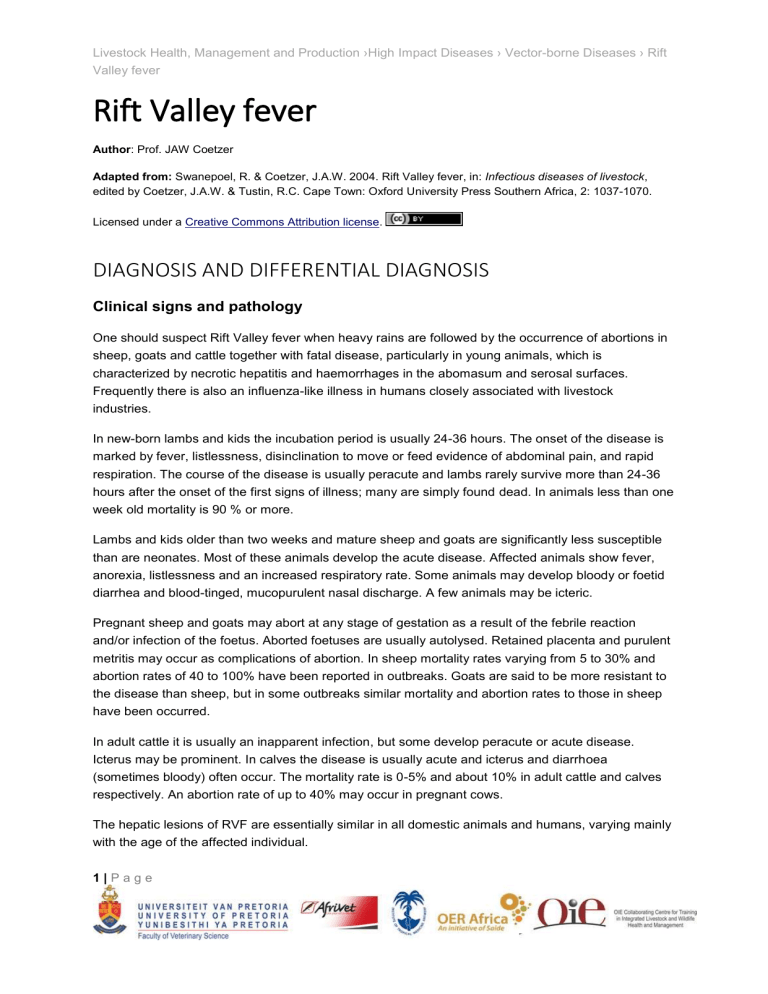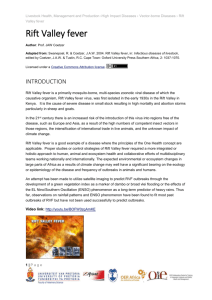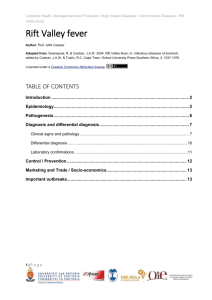05_rift_valley_fever_diagnosis_and_differential_diagnosis

Livestock Health, Management and Production ›High Impact Diseases › Vector-borne Diseases › Rift
Valley fever
Rift Valley fever
Author : Prof. JAW Coetzer
Adapted from: Swanepoel, R. & Coetzer, J.A.W. 2004. Rift Valley fever, in: Infectious diseases of livestock , edited by Coetzer, J.A.W. & Tustin, R.C. Cape Town: Oxford University Press Southern Africa, 2: 1037-1070.
Licensed under a Creative Commons Attribution license .
DIAGNOSIS AND DIFFERENTIAL DIAGNOSIS
Clinical signs and pathology
One should suspect Rift Valley fever when heavy rains are followed by the occurrence of abortions in sheep, goats and cattle together with fatal disease, particularly in young animals, which is characterized by necrotic hepatitis and haemorrhages in the abomasum and serosal surfaces.
Frequently there is also an influenza-like illness in humans closely associated with livestock industries.
In new-born lambs and kids the incubation period is usually 24-36 hours. The onset of the disease is marked by fever, listlessness, disinclination to move or feed evidence of abdominal pain, and rapid respiration. The course of the disease is usually peracute and lambs rarely survive more than 24-36 hours after the onset of the first signs of illness; many are simply found dead. In animals less than one week old mortality is 90 % or more.
Lambs and kids older than two weeks and mature sheep and goats are significantly less susceptible than are neonates. Most of these animals develop the acute disease. Affected animals show fever, anorexia, listlessness and an increased respiratory rate. Some animals may develop bloody or foetid diarrhea and blood-tinged, mucopurulent nasal discharge. A few animals may be icteric.
Pregnant sheep and goats may abort at any stage of gestation as a result of the febrile reaction and/or infection of the foetus. Aborted foetuses are usually autolysed. Retained placenta and purulent metritis may occur as complications of abortion. In sheep mortality rates varying from 5 to 30% and abortion rates of 40 to 100% have been reported in outbreaks. Goats are said to be more resistant to the disease than sheep, but in some outbreaks similar mortality and abortion rates to those in sheep have been occurred.
In adult cattle it is usually an inapparent infection, but some develop peracute or acute disease.
Icterus may be prominent. In calves the disease is usually acute and icterus and diarrhoea
(sometimes bloody) often occur. The mortality rate is 0-5% and about 10% in adult cattle and calves respectively. An abortion rate of up to 40% may occur in pregnant cows.
The hepatic lesions of RVF are essentially similar in all domestic animals and humans, varying mainly with the age of the affected individual.
1 | P a g e
Livestock Health, Management and Production ›High Impact Diseases › Vector-borne Diseases › Rift
Valley fever
The most severe lesions occur in aborted sheep foetuses and new-born lambs in which the liver is usually moderately to greatly enlarged, soft, friable and yellowish-brown to dark reddish-brown in colour with irregular congested patches and sometimes haemorrhages of varying size scattered throughout the parenchyma. Numerous greyish-white necrotic foci, 0,5 to 1,0mm in diameter, are invariably present in the parenchyma, but they may not be clearly discernible because of the discolouration of the organ. There may be oedema and haemorrhages in the wall of the gall bladder and hepatic lymph node. Mild icterus is evident in only about 10% of affected lambs because of the peracute course of the disease.
Numerous pin-point necrotic foci scattered throughout the parenchyma of the liver of a new-born lamb.
New-born lamb: Yellow-brown discoloration of the liver accompanied by congested patches, a few haemorrhages and greyishwhite necrotic foci in the organ.
New-born lamb: Massive hepatic necrosis
(only a narrow rim of intact hepatocytes periportal) and scattered foci of coagulative necrosis.
New-born lamb: Rod-shaped intranuclear inclusions in hepatocytes.
The hepatic lesions in adult sheep are generally not as severe or as widespread as in new-born lambs. Pin-point reddish to greyish-white necrotic foci may be distributed throughout the parenchyma, and in a small proportion of sheep there are larger centrilobular haemorrhages and necrotic lesions which impart a mottled appearance to the organ.
2 | P a g e
Livestock Health, Management and Production ›High Impact Diseases › Vector-borne Diseases › Rift
Valley fever
Adult sheep liver: Focal area of necrosis
Adult sheep gall bladder: Note blood-tinged bile and blood coagulum
Haemorrhages and oedema of the wall of the gall bladder are common, and the lumen may contain a blood coagulum or blood-tinged bile.
The livers of aborted calf foetuses, calves and adult cattle resemble those of adult sheep. The wall of the gall bladder is frequently oedematous and haemorrhagic.
Rift Valley fever is often a very haemorrhagic disease in cattle characterized by numerous haemorrhages in the serosal surfaces and tissues. The lumen of the abomasum and small and large intestines may contain copious amounts of free blood.
The hepatic lesions in new-born lambs are almost invariably accompanied by numerous petechiae and ecchymoses in the mucosa of the abomasum, and its contents are dark chocolate-brown as a result of the presence of partially-digested blood. The contents of the small intestine may be similar in appearance.
Most mature sheep and cattle have haemorrhages and oedema in the abomasal folds, and sometimes copious amounts of free blood in the lumen of the intestines.
3 | P a g e
Livestock Health, Management and Production ›High Impact Diseases › Vector-borne Diseases › Rift
Valley fever
Abomasum of an adult sheep: Note oedema of abomasum folds and numerous mucosal haemorrhages
In domestic ruminants the spleen is slightly too moderately enlarged, with haemorrhages in the capsule.
In domestic ruminants the peripheral and visceral lymph nodes are enlarged, oedematous, and may contain petechiae. Other changes include widespread subcutaneous, serosal and visceral haemorrhages, mild to moderate effusion of fluid, often blood-tinged, into body cavities, and congestion and oedema of the lungs.
Bovine spleen: Numerous capsular haemorrhages.
Petechial haemorrhages in the serosa of the large intestines of a bovine that died of RVF
4 | P a g e
Livestock Health, Management and Production ›High Impact Diseases › Vector-borne Diseases › Rift
Valley fever
Adult bovine: Oedema of the gall bladder wall accompanying haemorrhages in the mucosa and serosa of the bladder.
Differential diagnosis
Rift Valley fever, Wesselsbron disease and other arthropod-borne virus diseases tend to occur under the same climatic conditions. Rift Valley fever should be differentiated from Wesselsbron disease as both diseases can cause mortality in new-born lambs and kids. However, Rift Valley fever is associated with much higher mortality rates than Wesselsbron disease.
Agents causing mortality associated with hepatic lesions, haemorrhages and/or icterus which may superficially resemble Rift Valley fever in domestic ruminants include poisonings by plants such as
Senecio, Crotalaria and Cestrum species and an alga, Microcystis aeruginosa as well as bacterial septicaemias such as pasteurellosis, salmonellosis and anthrax. Nairobi sheep disease could also be confused with RVF.
A high percentage of pregnant sheep, goats or cattle may abort and diseases which must be eliminated by appropriate laboratory investigations include brucellosis, leptospirosis, chlamydiosis, salmonellosis, bovine viral diarrhoea, Simbu-group virus infections and Palyam virus infections.
Laboratory confirmations
Specimens to be submitted for laboratory confirmation of the diagnosis include heparinized or clotted blood, plasma or serum of live affected animals, or tissue samples, including liver, spleen, kidney, lymph nodes and heart blood of dead animals. Samples from aborted foetuses should include brain since this is usually less autolysed or putrefied than viscera.
Specimens should be securely packaged and submitted on ice to a suitable laboratory for isolation of virus or demonstration of antibody. Where delay in getting specimens to the laboratory is unavoidable or where material has to be transported at ambient temperature, tissue samples can be preserved in glycerol-saline solution.
5 | P a g e
Livestock Health, Management and Production ›High Impact Diseases › Vector-borne Diseases › Rift
Valley fever
Virus can be isolated readily in a variety of cell cultures, or in suckling and weaned mice or hamsters inoculated intracerebrally or intraperitoneally. Viral antigen detection is rapidly done in impression smears of infected tissues by immunofluorescence, in tissue sections by immunoperoxidase staining and in serum by ELISA. Viral nucleic acid can readily be detected in serum and other tissues of infected livestock and humans, as well as mosquitoes by means of a variety of highly sensitive polymerase chain reaction assays.
In animals that survive the disease, paired serum samples, one taken during the acute illness and the other 2-3 weeks later, should be submitted for retrospective diagnosis by means of antibody detection.
Tissue specimens from the liver, spleen, and lymph nodes should also be collected in 10% bufferedformalin for histopathological examination. Histopathological liver lesions are pathognomonic and, in particular, the hepatic lesions of new-born lambs leave little room for doubt about the diagnosis of
RVF.
Video link
: http://youtu.be/b0iEh78kisU
6 | P a g e






!["Human Origins in Africa" [BB09]](http://s2.studylib.net/store/data/005801692_1-b5b40078f7d5ae773e8789f2ec514d2f-300x300.png)

